Evolution Characteristics of Meteorological and Hydrological Drought in an Arid Oasis of Northwest China
Abstract
:1. Introduction
2. Materials and Methods
2.1. Study Area
2.2. Data Sources and Processing
2.3. Drought Indices
2.4. Trend and Mutation Analyses
2.5. ArcGIS Spatial Interpolation
2.6. Run Theory
3. Results
3.1. Temporal Evolution Characteristics of Meteorological and Hydrological Elements
3.2. Temporal and Spatial Characteristics of Meteorological Drought
3.2.1. Interannual Evolution Trend of Meteorological Drought
3.2.2. Seasonal Variation Trends of Meteorological Drought
3.2.3. Analysis of Annual Scale Meteorological Drought Frequency
3.2.4. Analysis of Annual Scale Meteorological Drought Frequency
3.2.5. Annual Variation Characteristics of Groundwater Table
3.3. Time Variation Characteristics of Hydrological Drought
3.3.1. Interannual Evolution Trend of Hydrological Drought
3.3.2. Seasonal Variation Trends of Hydrological Drought
3.3.3. Temporal Variation Characteristics of Hydrological Drought Frequency
3.3.4. Drought Characteristic Analysis
3.3.5. Evolution Trend of Multi-Scale Drought at Different Stations
4. Discussion
4.1. Characteristics of Drought and Runoff Changes
4.2. Relationship between Meteorological and Hydrological Droughts
5. Conclusions
- (1)
- Both meteorological and hydrological droughts decreased, and hydrological droughts decreased significantly. Meteorological droughts tended to increase in spring and autumn, whereas the basin became wetter during winter. The dry and wet conditions in spring and autumn remained relatively stable, with no abrupt changes. Abrupt changes in summer and winter occurred around 1983 and 1993, respectively, from drought to humidity. Except in spring, the SRI did not decrease significantly, and the SRIs in summer, autumn, and winter increased significantly (p < 0.01), indicating a shift from drought to humidity and a weakening of seasonal drought.
- (2)
- Meteorological droughts at different time scales and intensities exhibited similar characteristics. Light and moderate droughts are commonly observed at the annual and seasonal scales, whereas severe and extreme droughts are relatively infrequent. In terms of geographic distribution, the northern part of the study region has experienced frequent light and extreme droughts, whereas the southern part has tended to experience more severe droughts during the summer months. Conversely, severe droughts in autumn were more likely to occur in the north. Basin managers can make appropriate water resource allocation plans based on this to effectively reduce the probability of drought. In addition, in this study, Shawan and Mosso Bay are prone to severe and extreme droughts, so it is important for watershed managers to pay more attention to prevention. From the perspective of meteorological drought frequency, there were no significant changes in the occurrence of light or moderate droughts during the 2010s. However, the frequency of severe and extreme droughts increased during the same period. Hydrological droughts have become less common since the 1990s. Overall, these findings suggest that the frequency of severe and extreme droughts has increased, whereas the frequency of light and moderate droughts has remained relatively stable.
- (3)
- The significant increase in runoff in the MRB during the 1990s could be related to the accelerated glacier retreat that occurred at the same time in the central and western Tianshan Mountains. Hydrological drought, which follows meteorological drought, is inevitably delayed and occurs after meteorological drought.
Author Contributions
Funding
Data Availability Statement
Acknowledgments
Conflicts of Interest
References
- Wang, R.; Zhang, X.; Guo, E.; Cong, L.; Wang, Y. Characteristics of the Spatial and Temporal Distribution of Drought in Northeast China, 1961–2020. Water 2024, 16, 234. [Google Scholar] [CrossRef]
- Chen, W.H.; Xu, J.; Li, S.C. Study on meteorological and hydrological drought characteristics in the lower reaches of Nujiang River Basin. Acta Sci. Nat. Univ. Pekin. 2019, 55, 764–772. [Google Scholar]
- Xue, H.Z.; Li, Y.Y.; Dong, G.T. Analysis of spatiotemporal variation of meteorological drought in Hexi Corridor based on SPEI index. Chin. J. Agrometeorol. 2022, 43, 923–934. [Google Scholar]
- Zhang, L.; Zhang, Z.; Peng, Z.; Xu, Y.; Zhang, Y.; Mao, J. Linkages between Meteorological and Hydrological Drought in the Jinsha River Basin under a Changing Environment. Water 2023, 15, 3644. [Google Scholar] [CrossRef]
- Jiang, D.B.; Wang, X.X. Interpretation of drought change in IPCC Sixth Assessment Report. Trans. Atmos. Sci. 2019, 44, 650–653. [Google Scholar]
- Zhang, X.; Huang, S.Z.; Guan, Y.H. Research progress, challenges and prospects of drought propagation. Adv. Earth Sci. 2023, 38, 563–579. [Google Scholar]
- Mo, C.; Tang, P.; Huang, K.; Lei, X.; Lai, S.; Deng, J.; Bao, M.; Sun, G.; Xing, Z. Evolution of Drought Trends under Climate Change Scenarios in Karst Basin. Water 2023, 15, 1934. [Google Scholar] [CrossRef]
- Gao, F.; Liu, J.; Chen, W.; Yang, S.K.; Feng, H. Study on meteorological and hydrological drought propagation characteristics and response probability in the upper reaches of Huaihe River Basin. Res. Soil Water Conserv. 2023, 30, 257–265. [Google Scholar] [CrossRef]
- Mukti, R.S.; Wei, M.X.; Christopher, B.E.; Sandra, R.H.; Ming, Y. Tree mortality and biomass loss in drought-affected forests of East Texas, USA. J. For. Res. 2021, 32, 67–80. [Google Scholar]
- Chen, Y.N.; Li, Z.Q.; Xu, J.H.; Shen, Y.J.; Xing, X.X.; Xie, T.; Li, Z.; Yang, L.S.; Xi, H.Y.; Zhu, C.G.; et al. Changes of water resources and ecological environment in arid area of Northwest China and their protection suggestions. Bull. Chin. Acad. Sci. 2023, 38, 385–393. [Google Scholar]
- Yang, D.; Xiong, W.; Xu, Y.L. Impacts of climate change on water resources and agriculture in Africa. Chin. J. Agrometeorol. 2016, 37, 259–269. [Google Scholar]
- Yang, S.K.; Liu, J.; Zhang, T.; Peng, T.; Chang, W.J. Study on the probability of meteorological and hydrological drought characteristic variables response in the upper reaches of Hanjiang River. Water Resour. Prot. 2023, 39, 143–151. [Google Scholar] [CrossRef]
- Li, X.; Jiao, Y.; Liu, J. Changes in Drought Characteristics in the Yellow River Basin during the Carbon-Neutral Period under Low-Emission Scenarios. Water 2024, 16, 1045. [Google Scholar] [CrossRef]
- Cao, S.P.; Zhang, L.F.; He, Y.; Zhang, Y.L.; Chen, Y.Y.; Sheng, Y.; Wang, S.Q. Effects and contributions of meteorological drought on agricultural drought under different climatic zones and vegetation types in Northwest China. Sci. Total Environ. 2022, 821, 153270. [Google Scholar] [CrossRef] [PubMed]
- Liu, Q.; Huo, A.; Zhao, Z.; Zhao, X.; Rebouh, N.Y.; Luo, C. Spatial Differentiation and Influencing Factors Analysis of Drought Characteristics Based on the Standardized Precipitation Index: A Case Study of the Yellow River Basin. Water 2024, 16, 1337. [Google Scholar] [CrossRef]
- Xu, Y.R.; Lu, F.; Xie, Z.B.; Zhu, K.; Song, X.Y. Meteorological and hydrological drought characteristics and their response relationship in Chaobai River Basin. Agric. Res. Arid. Areas 2019, 37, 220–228. [Google Scholar]
- Xue, L.Q.; Bai, Q.Y.; Liu, Y.H. The propagation of meteorological drought to hydrological drought in Tarim River Basin under the influence of human activities. Water Resour. Prot. 2019, 39, 57–72. [Google Scholar]
- Meng, D.; Huang, S.Z.; Huang, Q.; Zheng, X.D.; Su, X.L.; Leng, G.Y.; Li, Z.Y.; Fang, W.; Liu, Y.J. Propagation characteristics and mechanism from meteorological to agricultural drought in various seasons. J. Hydrol. 2022, 610, 127897. [Google Scholar]
- Liu, Q.; Yang, Y.T.; Liang, L.Q.; Jun, H.; Yan, D.H.; Wang, X.; Li, C.H.; Sun, T. Thresholds for triggering the propagation of meteorological drought to hydrological drought in water-limited regions of China. Sci. Total Environ. 2023, 876, 162771. [Google Scholar] [CrossRef]
- Qiong, F.L.; Peng, F.H.; Yong, C.H.; Xing, Y.H.; Tian, S.Z.; Guo, B.L.; Hong, J.W. Investigation to the relation between meteorological drought and hydrological drought in the upper Shaying River Basin using wavelet analysis. Atmos. Res. 2020, 234, 104743. [Google Scholar]
- Gao, Q.; Sun, J.W.; Zhao, X.X.; Wu, L.F.; Zhao, J. Multi-scale spatiotemporal characteristics of drought in China based on SPEI. Water. Saving. Irrig. 2024, 6, 111–120+127. [Google Scholar]
- Muhammad, J.; Muhammad, N.S.; Joo-Heon, L.; Tae-Woong, K. Investigating effect of climate change on drought propagation from meteorological to hydrological drought using multi-model ensemble projections. Stoch. Environ. Res. Risk Assess. 2020, 34, 7–21. [Google Scholar]
- Li, S.; Zeng, L.; Zhang, C.J.; Xiao, Q.; Zhang, Q.; Gong, W.T. Temporal and spatial variations of meteorological drought and hydrological drought in the upper reaches of the Yangtze River in recent 120 years and their transmission characteristics. Clim. Chang. Res. 2023, 19, 263–277. [Google Scholar]
- Qin, J.L.; Xue, L.Q. Spatial and temporal variation of vegetation and its relationship with topographic factors in Manas River Basin, arid region of Northwest China. Ecol. Environ. Sci. 2019, 29, 2179–2188. [Google Scholar]
- Chen, F.L.; Yang, K.; Cai, W.J. Research on hydrological drought index based on GAMLSS model: A case study of Manas River Basin. Geogr. Res. 2021, 40, 2670–2683. [Google Scholar]
- Thornthwaite, C.W. An approach toward a rational classification of climate. Geogr. Rev. 1948, 38, 55–94. [Google Scholar] [CrossRef]
- Fu, Y.H.; Shen, X.J.; Li, W.C.; Wu, X.; Zhang, Q.Q. Applicability of crop reference evapotranspiration calculation based on Hargreaves-Samani regression modification. Arid. Land Geogr. 2022, 45, 1752–1760. [Google Scholar]
- Wu, Z.J.; Cui, N.B.; Xu, J.Z.; Cui, Y.L.; Liang, J. Prediction of reference crop evapotranspiration in Guangxi Basin by improved Hargreaves-Samani model. J. Drain. Irrig. Mach. Eng. 2022, 40, 404–410. [Google Scholar]
- Shi, P.; Zhan, H.J.; Qu, S.M.; Feng, J.; Guan, X.X. Correlation analysis of meteorological drought and hydrological drought in the source region of the Yellow Rive. Water Resour. Prot. 2022, 38, 80–86. [Google Scholar]
- Chen, Y.; Shen, H.; Wang, X.H.; Zhao, W.K.; Pan, Z.J.; Wang, J.Y.; Li, S.Y.; Han, D. Urban energy carbon peak assessment method based on Mann-Kendall trend test. J. Shanghai Jiaotong Univ. 2023, 57, 928–938. [Google Scholar]
- Li, C.Y.; Cui, P.; Hao, J.S.; Zhang, G.T.; Wang, J. Variation characteristics of temperature and precipitation in southeast Tibet since 1960. Plateau Meteorol. 2019, 42, 344–358. [Google Scholar]
- Jia, Y.; Cui, N.B.; Wei, X.P.; Gong, D.Z.; Hu, X.T. Applicability evaluation of reference crop evapotranspiration algorithm in Yangtze River Basin based on inverse distance weighting method. Trans. Chin. Soc. Agric. Eng. 2016, 32, 130–138. [Google Scholar]
- Beshr Ashraf, A.A.; Kaloop, M.R. Using modified inverse distance weight and principal component analysis for spatial in-terpolation of foundation settlement based on geodetic observations. Open Geosci. 2022, 14, 1310–1323. [Google Scholar] [CrossRef]
- Shi, P.; Tang, H.; Qu, S.M. Characteristics of meteorological drought to hydrological drought propagation in Southwest China. Water Resour. Prot. 2019, 39, 49–56. [Google Scholar]
- Yao, J.Q.; Li, M.Y.; Dilinur, T.; Chen, J.; Mao, W.Y. Characteristics of climate warming and humidification at dif-ferent time scales in Xinjiang. Arid. Zone Res. 2022, 39, 333–346. [Google Scholar]
- Zhang, Z.Y.; Li, Z.Q.; He, X.L.; Liu, L.; Wang, P.Y. Research progress of glacier change and water resources in Manas River Basin. Res. Soil Water Conserv. 2014, 21, 332–337. [Google Scholar]
- Wang, Y.J.; Xu, L.P.; Guo, P.; Li, H.T. Trend analysis of ice and snow cover in Mahe River Basin from 1977 to 2013. Res. Soil Water Conserv. 2015, 22, 208–218. [Google Scholar]
- Zhang, Z.Y.; Liu, L.; Tang, X.L. Regional variation and abrupt change of precipitation in the Tianshan Mountains of China in recent 50 years. J. Arid. Land Resour. Environ. 2013, 27, 85–90. [Google Scholar]
- Yao, J.Q.; Li, M.Y.; Dilinur, T. The signal and influence of “wet-dry transition” in Xinjiang. Acta Geogr. Sin. 2021, 76, 57–72. [Google Scholar]
- Zhou, Z.Q.; Shi, H.Y.; Fu, Q.; Ding, Y.B.; Li, T.X.; Wang, Y.; Liu, S.N. Characteristics of Propagation from Mete-orological Drought to Hydrological Drought in the Pearl River Basin. J. Geophys. Res. Atmos. 2021, 126, e2020JD033959. [Google Scholar] [CrossRef]
- Han, R. Impact of Climate Change on Snow Melt in Manas River Basin. Master’s Thesis, Shihezi University, Shihezi, China, 2017. [Google Scholar]
- Zheng, L.H.; Liu, Y.; Ren, L.L.; Zhu, H.; Yi, H. Temporal and spatial characteristics of meteorological drought and hydrological drought in the Yellow River Basin. Water Resour. Prot. 2022, 38, 87–95+146. [Google Scholar]
- Zhi, X.F.; Tian, Y.T.; Chen, C.C. Research progress and prospects of drought transmission II: Influencing factors and prospects of drought transmission research. South-North Water Divers. Water Conserv. Sci. Technol. 2023, 21, 654–668. [Google Scholar]
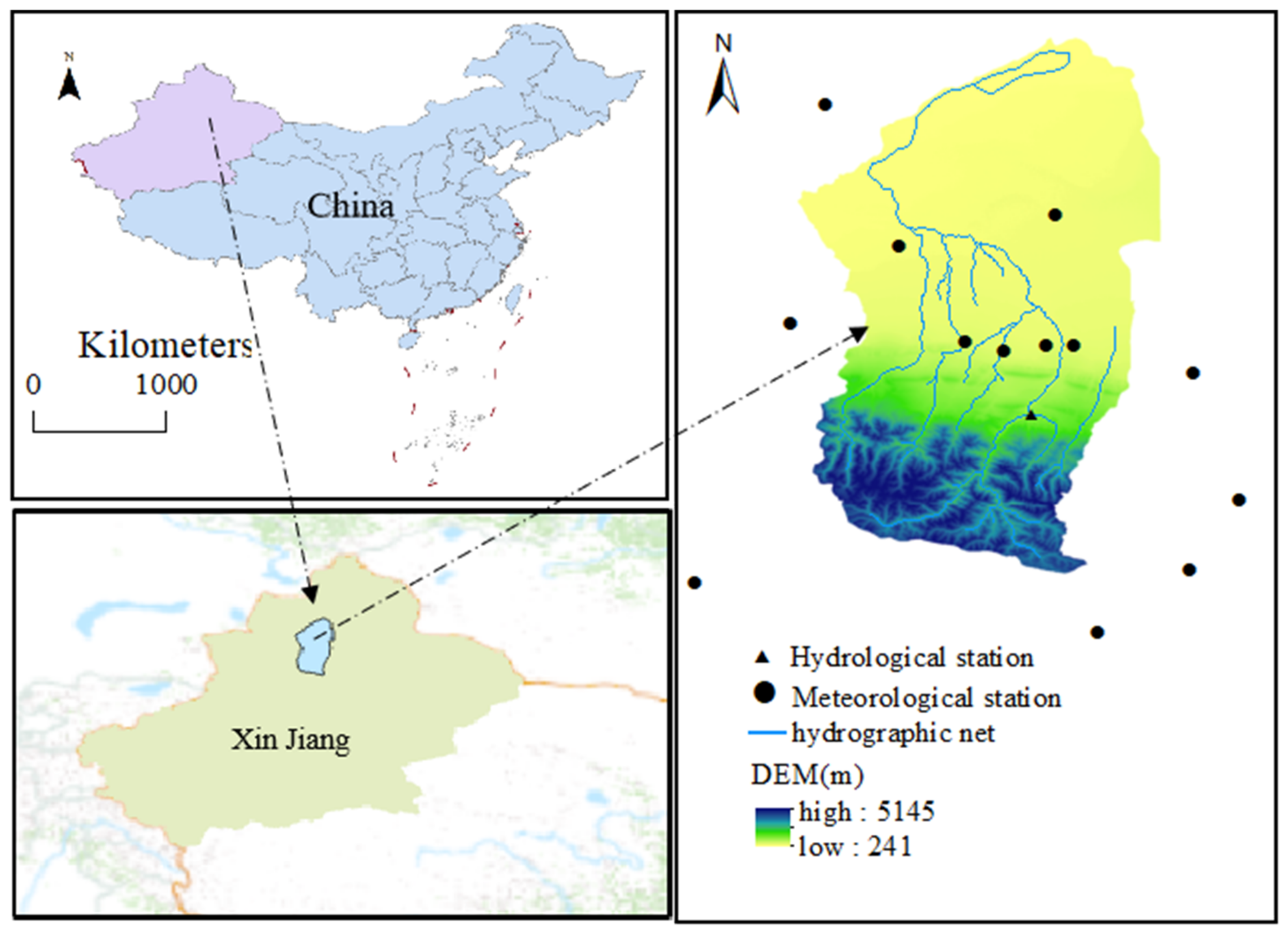
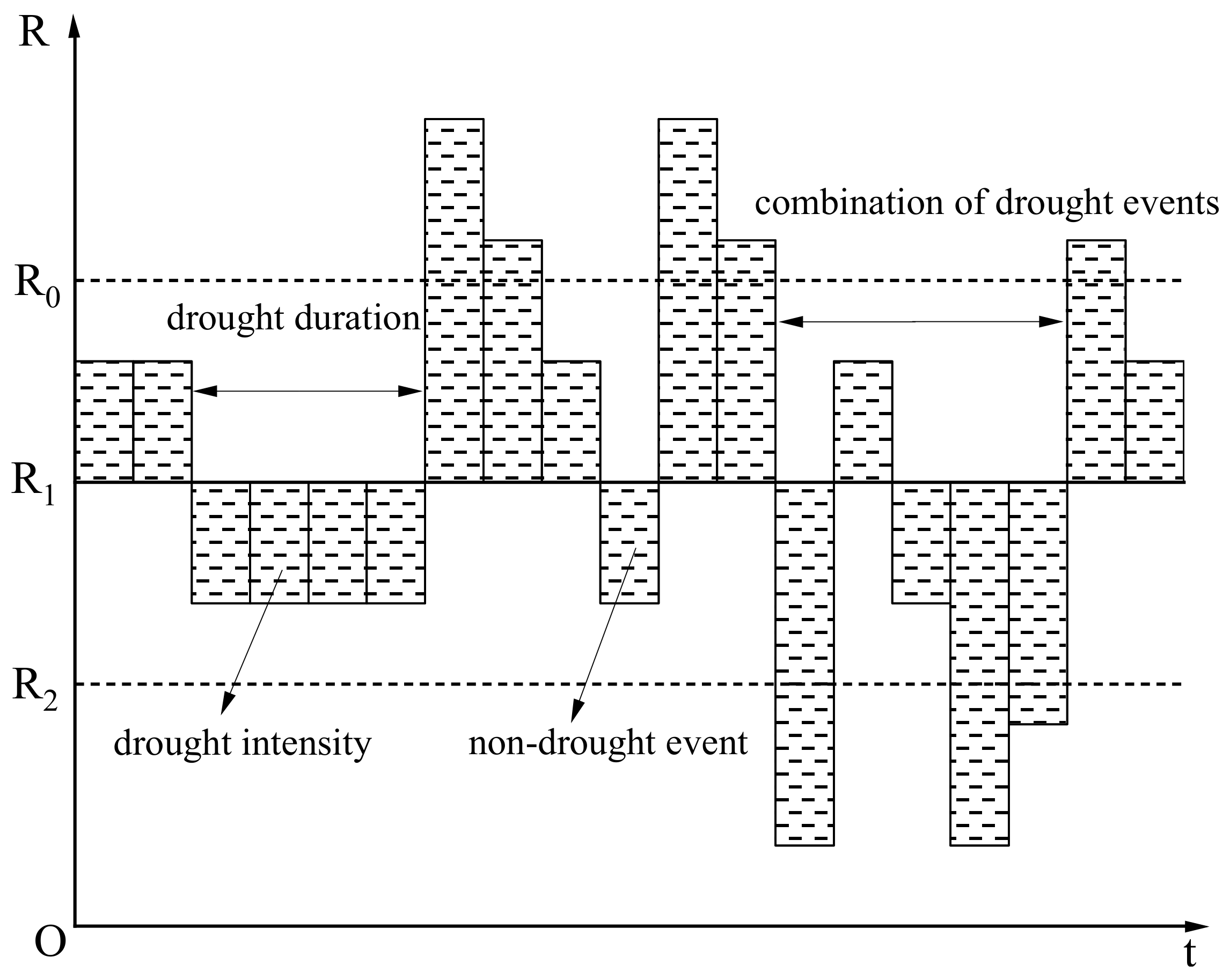


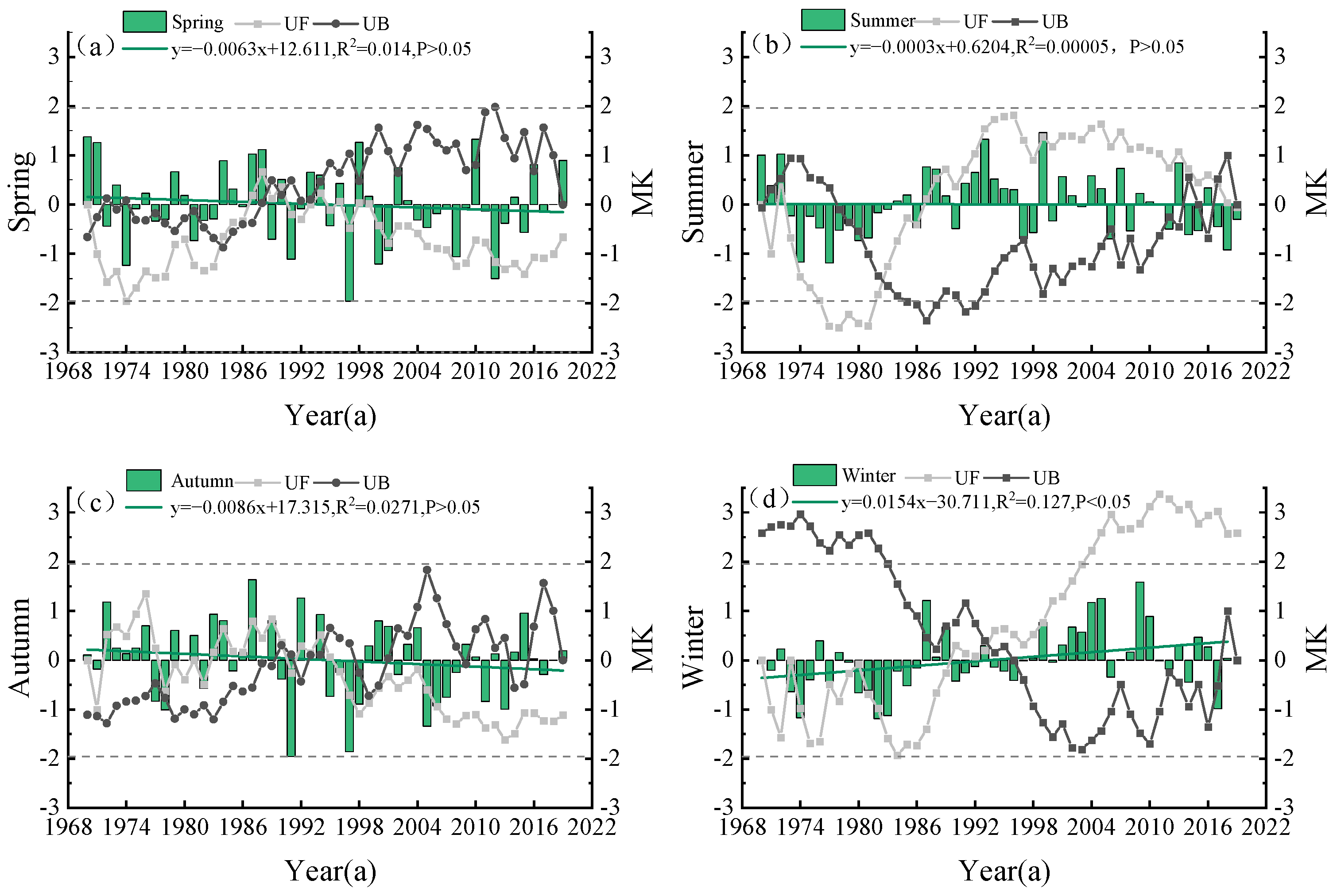
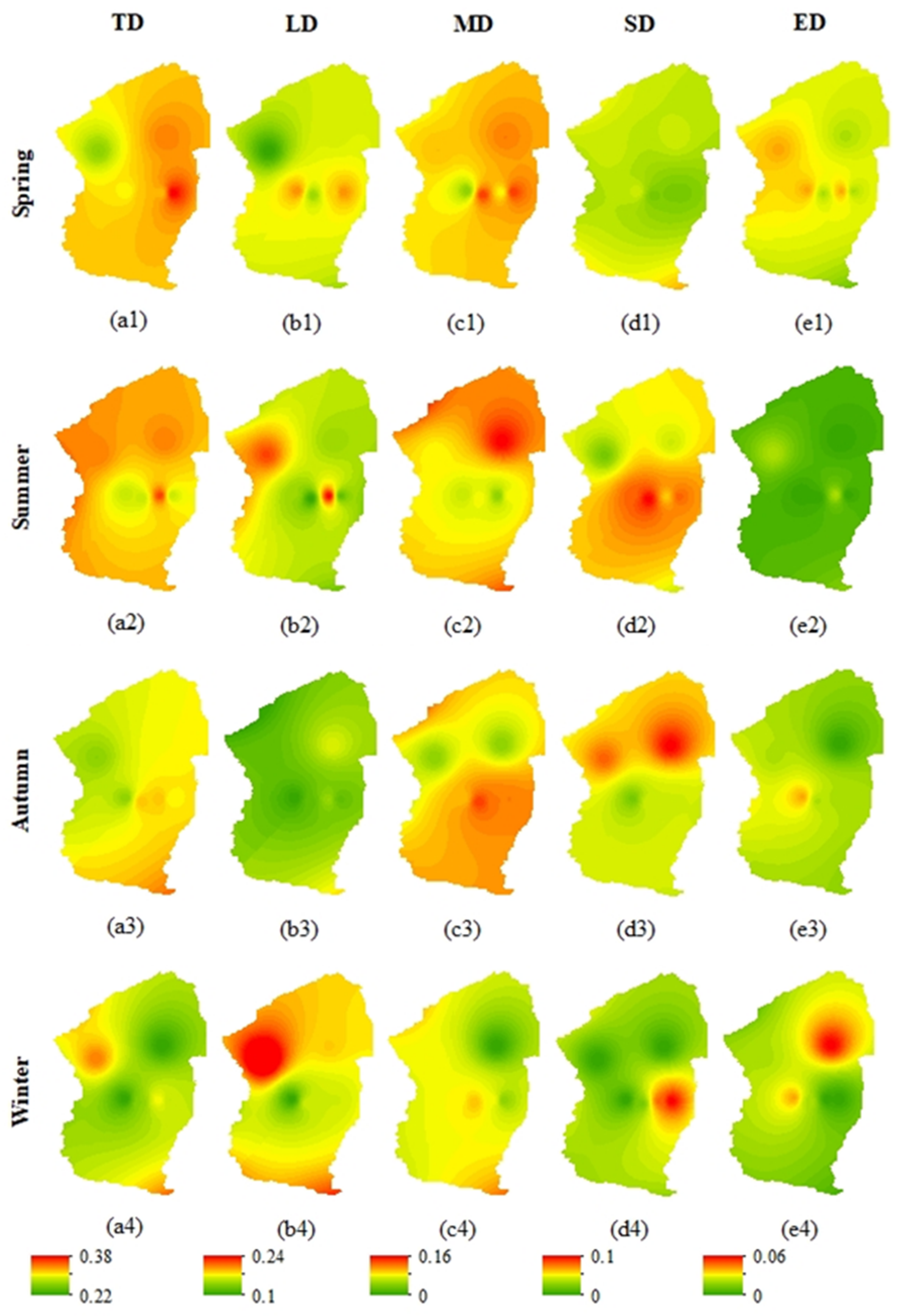

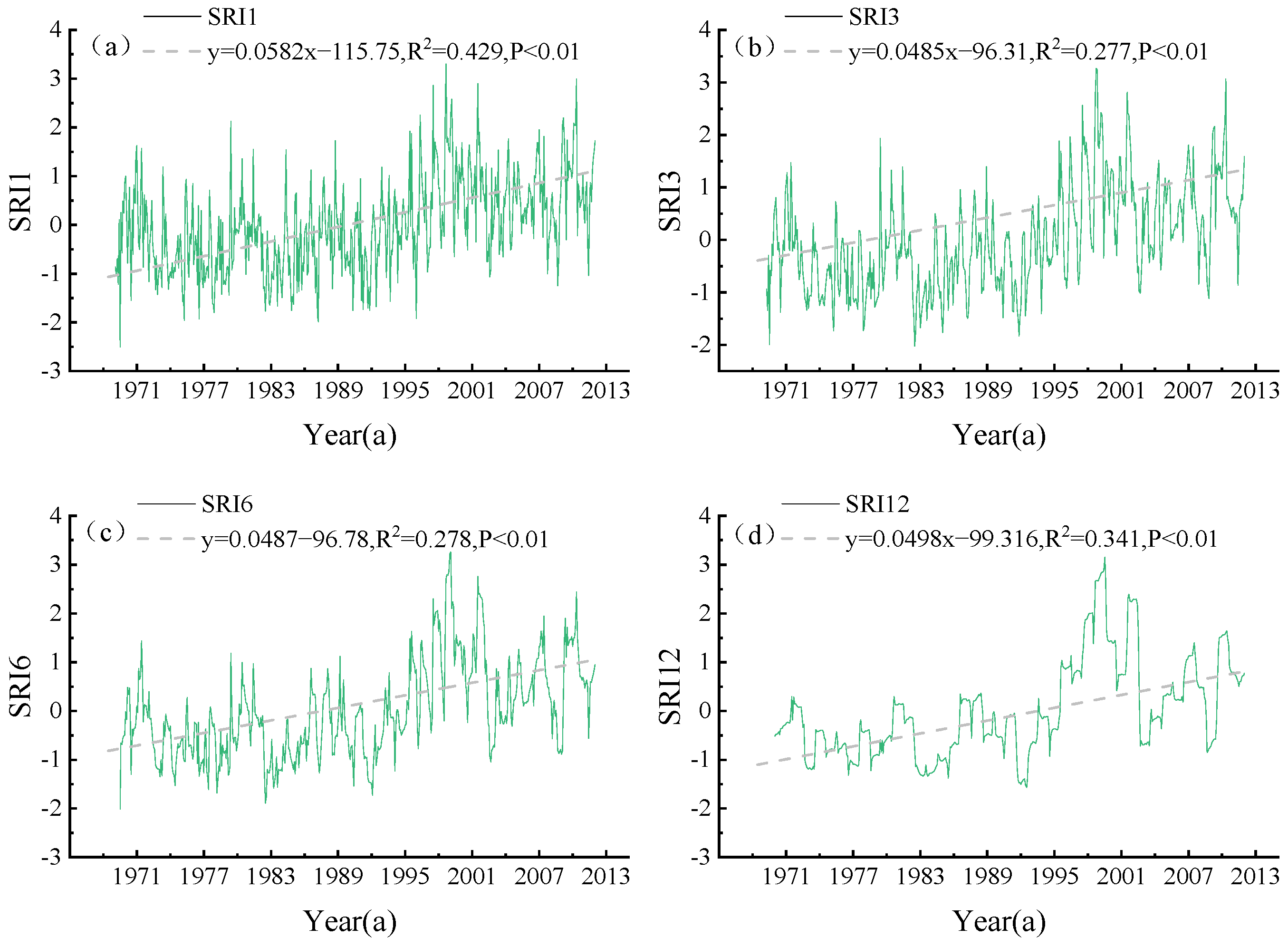



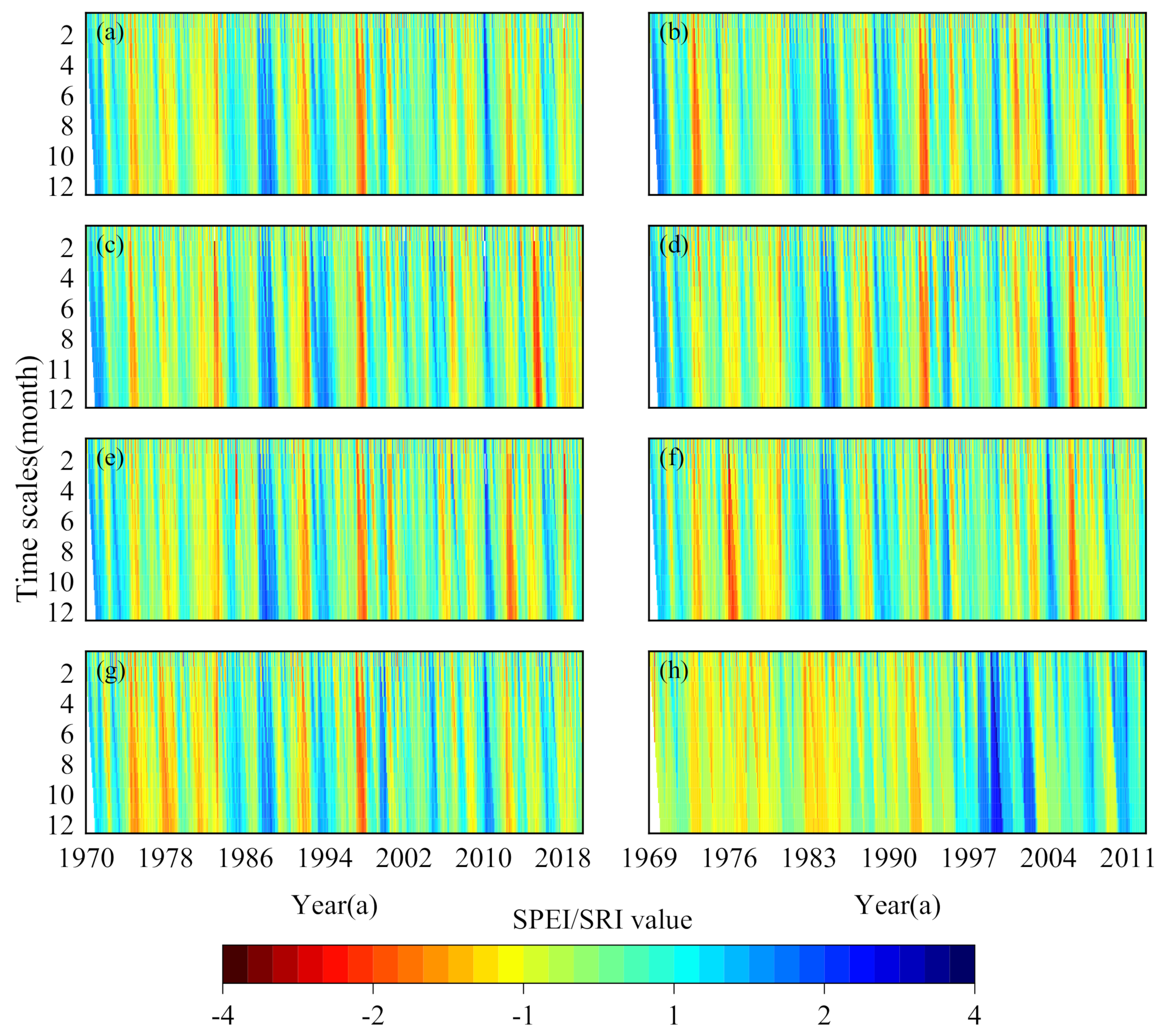
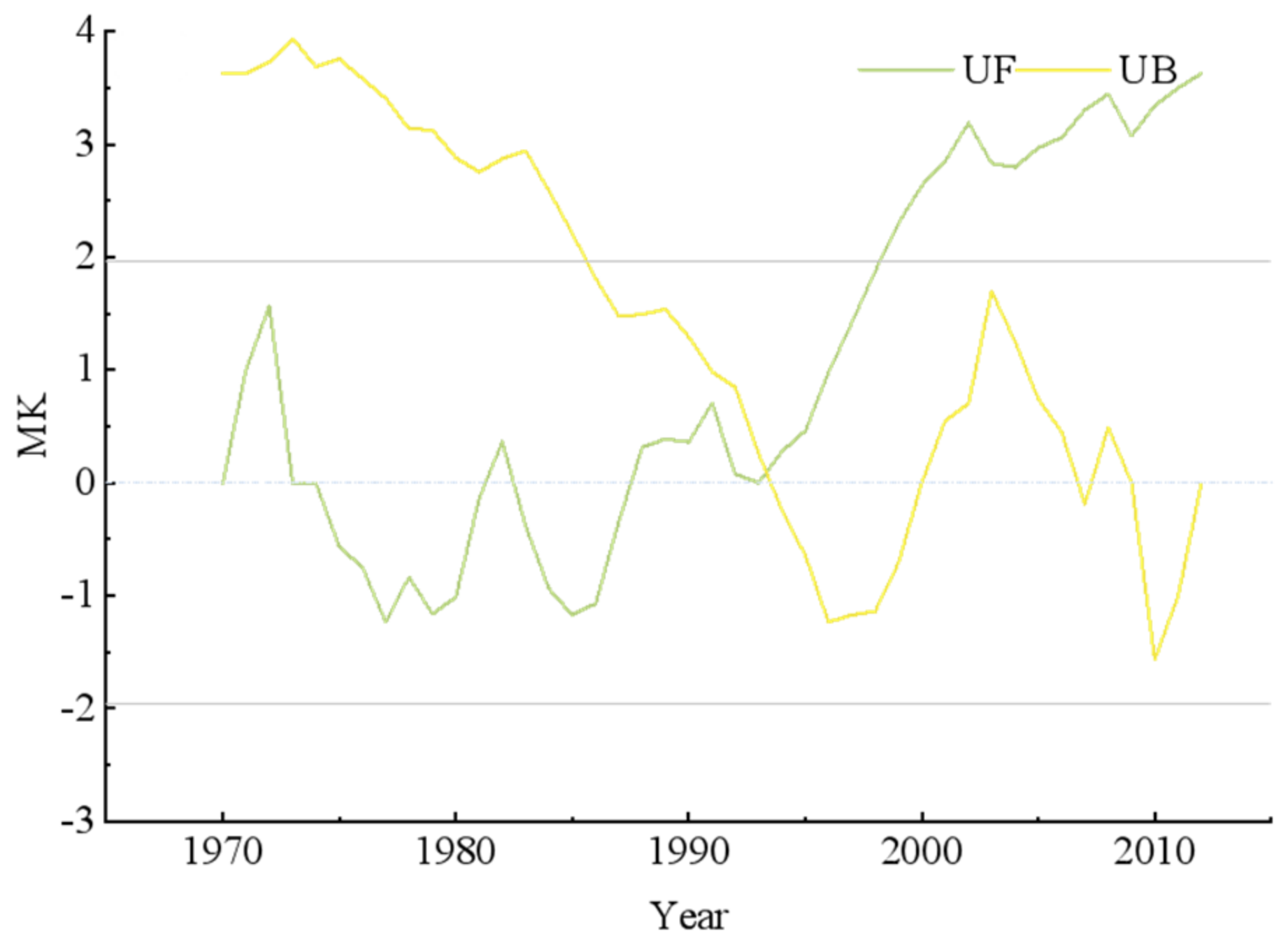
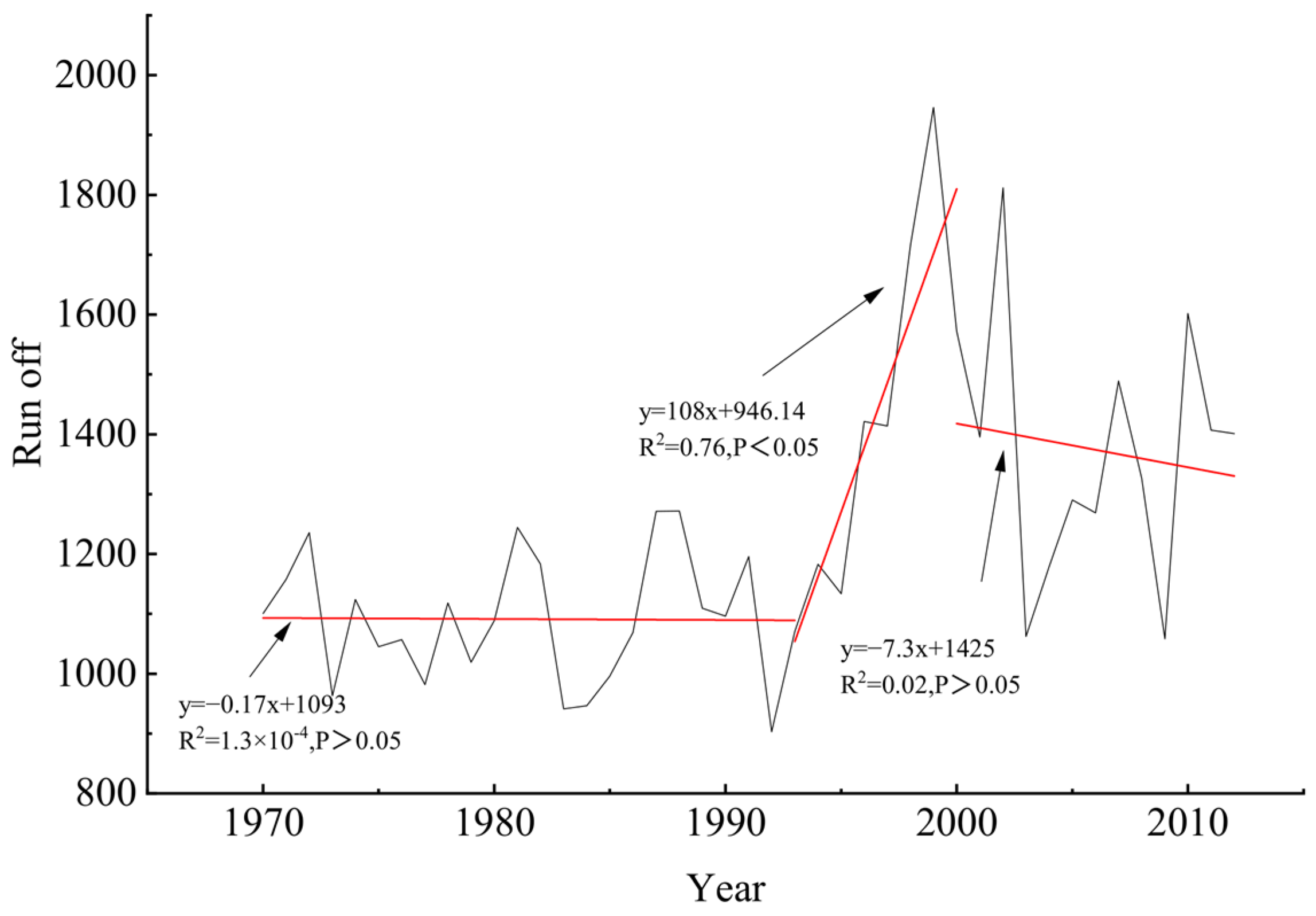
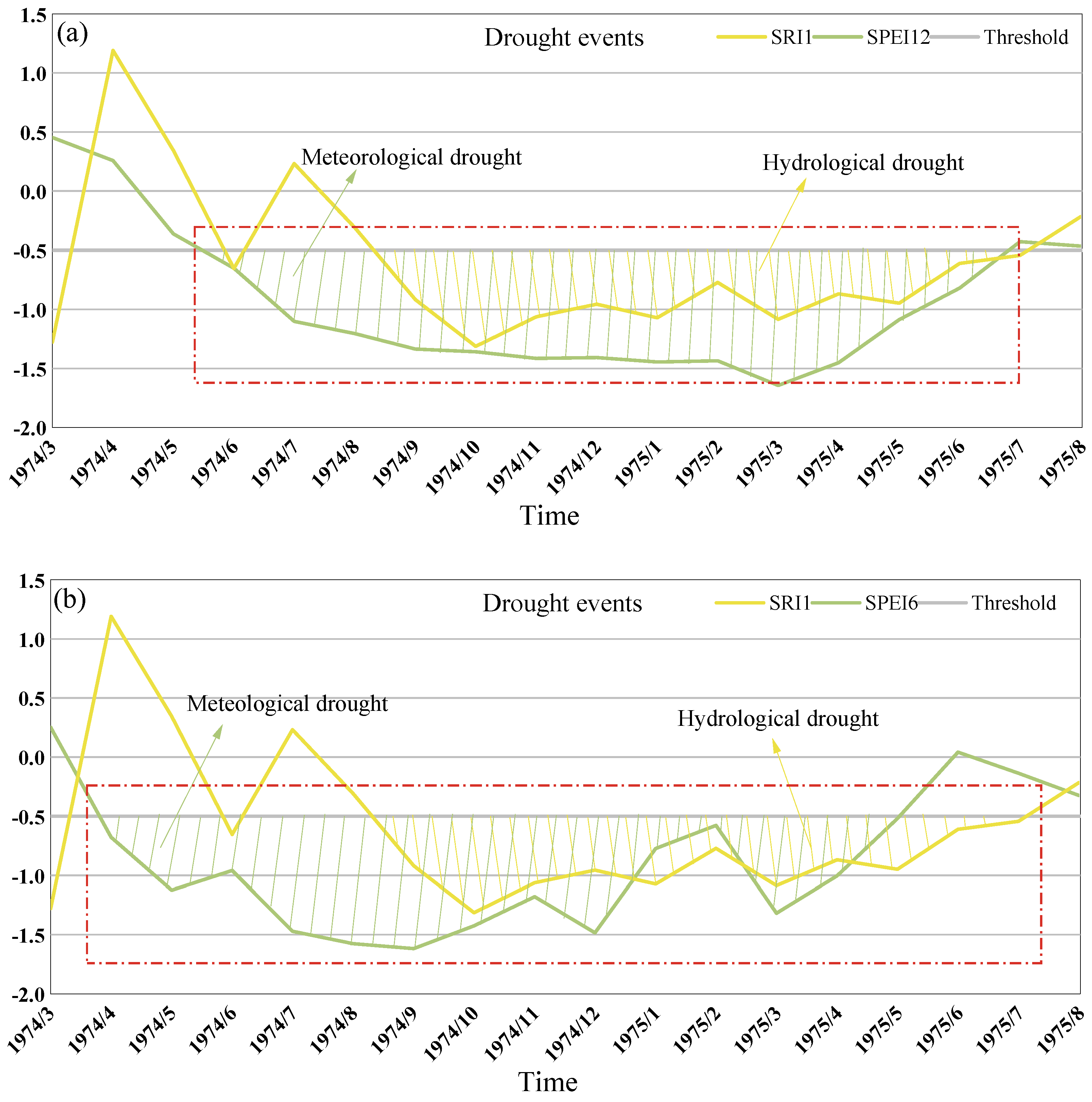
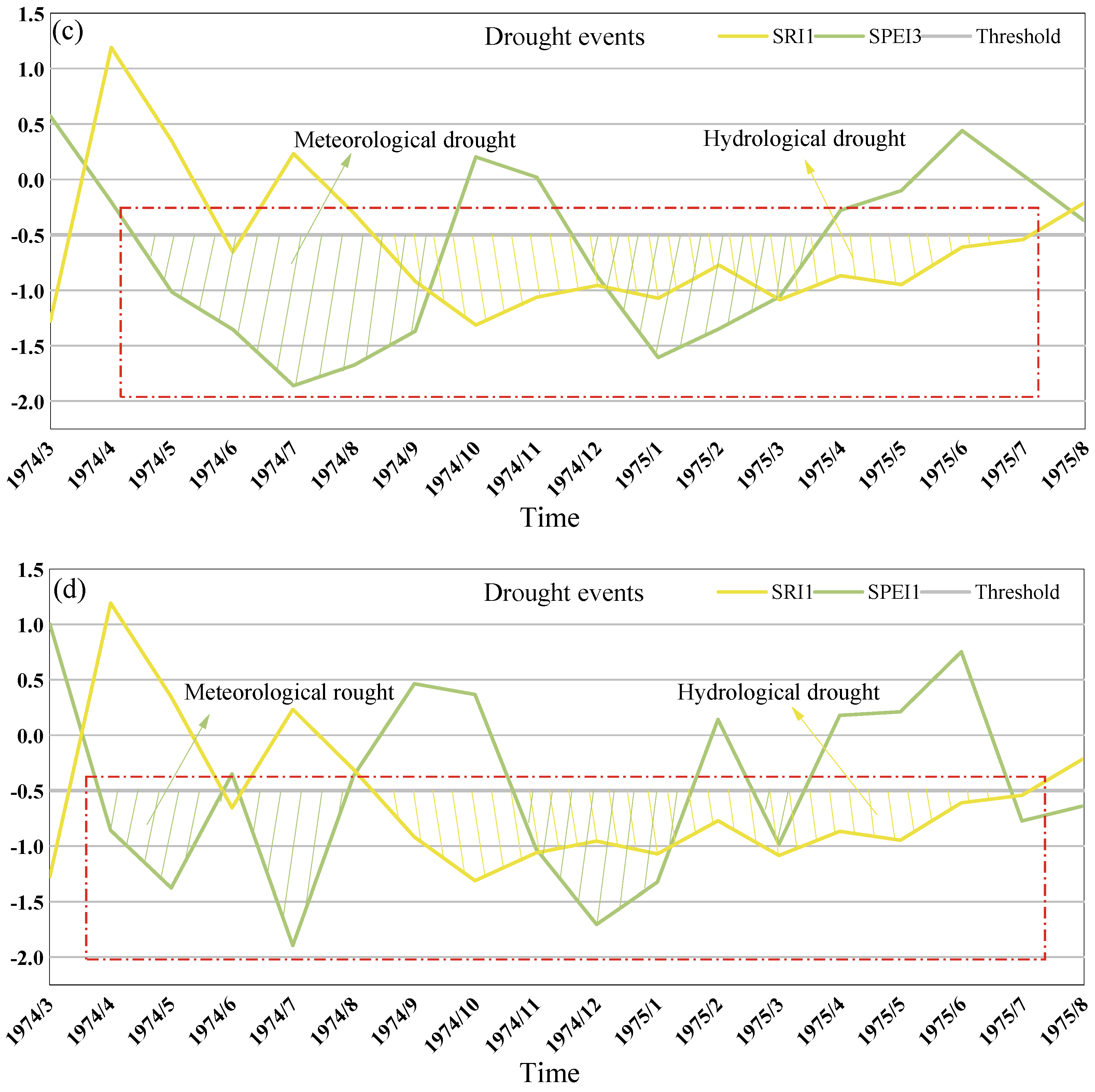
| Drought Classes | SPEI | SRI |
|---|---|---|
| No drought/wet | >0.5 | >0.5 |
| Near normal | (−0.5, 0.5] | (−0.5, 0.5] |
| Light drought | (−1.0, −0.5] | (−1.0, −0.5] |
| Moderate drought | (−1.5, −1.0] | (−1.5, −1.0] |
| Severe drought | (−2.0, −1.5] | (−2.0, −1.5] |
| Extreme drought | ≤−2.0 | ≤−2.0 |
| Station | TD | LD | MD | SD | ED |
|---|---|---|---|---|---|
| Paotai | 29% | 14% | 8% | 5% | 2% |
| Mosowan | 30% | 14% | 8% | 5% | 2% |
| Shihezi | 32% | 16% | 9% | 5% | 2% |
| Shawan | 30% | 13% | 12% | 4% | 2% |
| Wulanwusu | 28% | 11% | 11% | 4% | 3% |
| Manas | 31% | 13% | 10% | 6% | 1% |
Disclaimer/Publisher’s Note: The statements, opinions and data contained in all publications are solely those of the individual author(s) and contributor(s) and not of MDPI and/or the editor(s). MDPI and/or the editor(s) disclaim responsibility for any injury to people or property resulting from any ideas, methods, instructions or products referred to in the content. |
© 2024 by the authors. Licensee MDPI, Basel, Switzerland. This article is an open access article distributed under the terms and conditions of the Creative Commons Attribution (CC BY) license (https://creativecommons.org/licenses/by/4.0/).
Share and Cite
Dan, Y.; Tian, H.; Farid, M.A.; Yang, G.; Li, X.; Li, P.; Gao, Y.; He, X.; Li, F.; Liu, B.; et al. Evolution Characteristics of Meteorological and Hydrological Drought in an Arid Oasis of Northwest China. Water 2024, 16, 2088. https://doi.org/10.3390/w16152088
Dan Y, Tian H, Farid MA, Yang G, Li X, Li P, Gao Y, He X, Li F, Liu B, et al. Evolution Characteristics of Meteorological and Hydrological Drought in an Arid Oasis of Northwest China. Water. 2024; 16(15):2088. https://doi.org/10.3390/w16152088
Chicago/Turabian StyleDan, Yier, Hao Tian, Muhammad Arsalan Farid, Guang Yang, Xiaolong Li, Pengfei Li, Yongli Gao, Xinlin He, Fadong Li, Bing Liu, and et al. 2024. "Evolution Characteristics of Meteorological and Hydrological Drought in an Arid Oasis of Northwest China" Water 16, no. 15: 2088. https://doi.org/10.3390/w16152088






